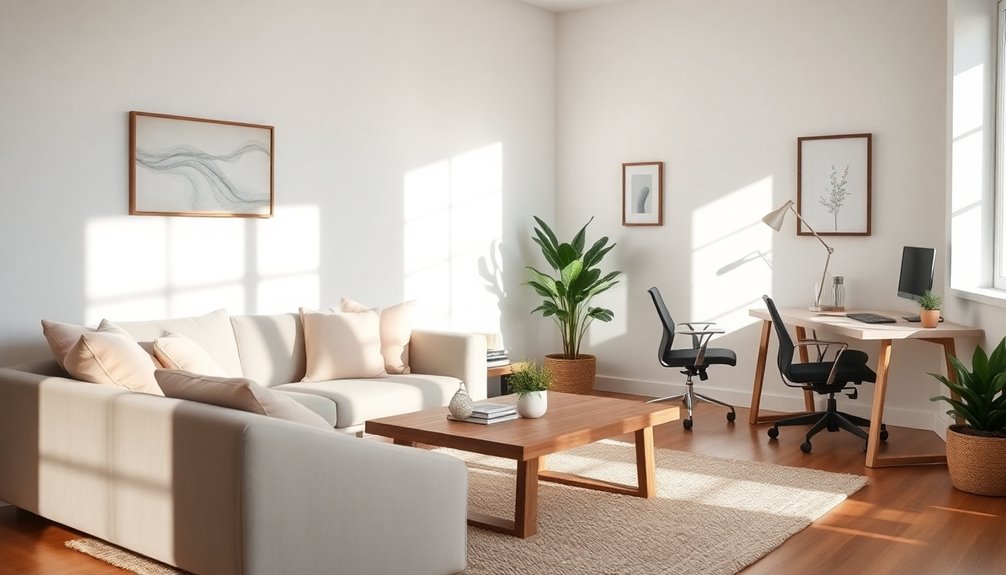To create a cohesive multi-purpose room, start by evaluating your current and future needs. Develop a unified color palette with three main colors, using one for walls and the others for accents. Incorporate versatile furniture that serves multiple functions and maximize space with a strategic layout. Add personal touches through decor while maintaining a clutter-free environment with decorative storage solutions. By paying attention to these details, you’ll guarantee a welcoming atmosphere for all activities. There’s more to explore on how to fine-tune your space!
Key Takeaways
- Develop a unified color palette with three colors or less to create a cohesive look throughout the room.
- Incorporate multi-purpose furniture to maximize space and ensure functionality for various activities.
- Define functional zones using area rugs to create distinct areas for different uses while maintaining a cohesive flow.
- Add personal touches, such as artwork and decorative accessories, that align with your chosen color palette for emotional connection.
- Regularly reassess the layout and storage solutions to adapt to evolving needs and maintain an organized environment.
Assessing Current and Future Needs
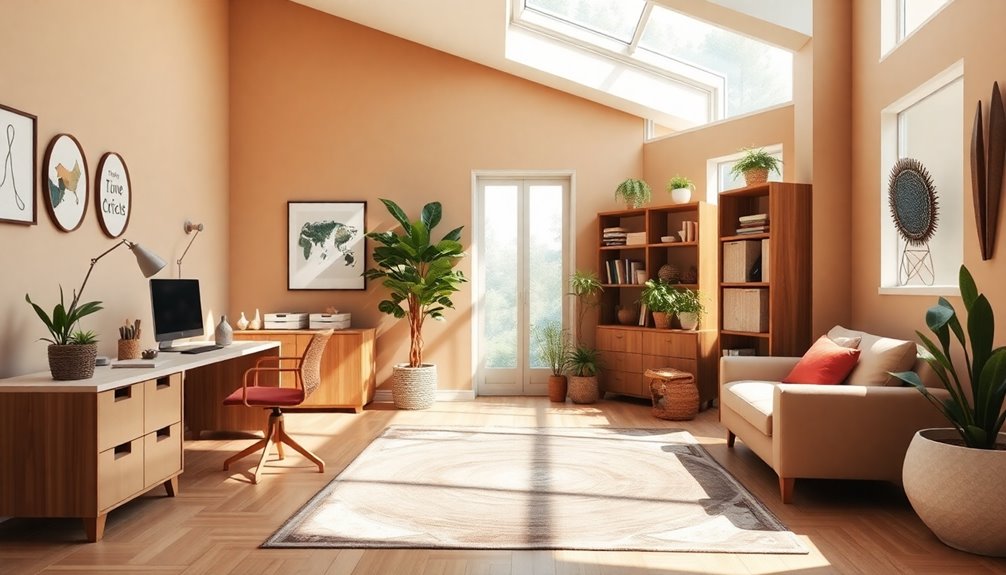
When planning a multi-purpose room, how do you assess your current and future needs? Start by evaluating the space’s primary functions, like storage, play, or work.
Consider how these needs might evolve, such as converting a storage area into a playroom as your children grow. It’s crucial to identify various activities that will occur in the room, guaranteeing it retains its functionality without sacrificing comfort.
Think about seasonal adaptations, like creating a cozy reading nook in winter while keeping it playful for summer activities. Incorporating open floor plans can enhance the space and flow between different functional areas.
Regularly revisit your needs and adjust the layout to maintain relevance over time. This proactive approach guarantees your multi-purpose room remains effective and enjoyable for everyone in your family.
Developing a Unified Color Palette
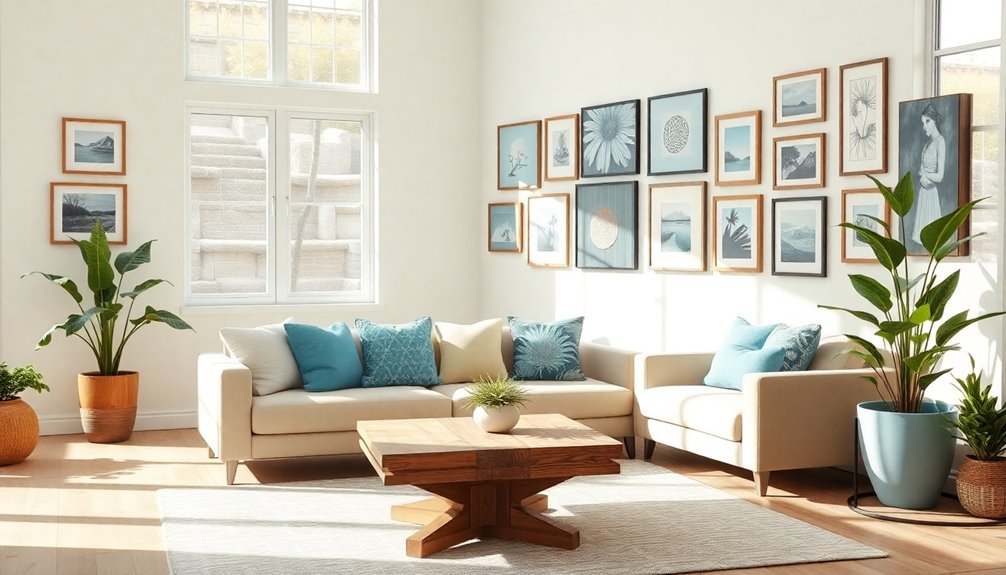
After evaluating your current and future needs for the multi-purpose room, it’s time to focus on developing a unified color palette. Limit your choices to three colors or less to maintain a cohesive look.
Use the main color prominently on walls or larger furniture, while incorporating accent colors in accessories and textiles for visual interest. Consider using warm neutrals, as they promote relaxation and comfort, perfect for a space that serves multiple purposes. Additionally, integrating natural materials can enhance the overall ambiance and create a more inviting environment.
Blend colors between adjacent rooms to create a seamless flow, ensuring each area feels connected. Before making final selections, lay out color swatches on paper to visualize how different paint colors interact and complement one another within your chosen color scheme.
Incorporating Multi-Purpose Furniture
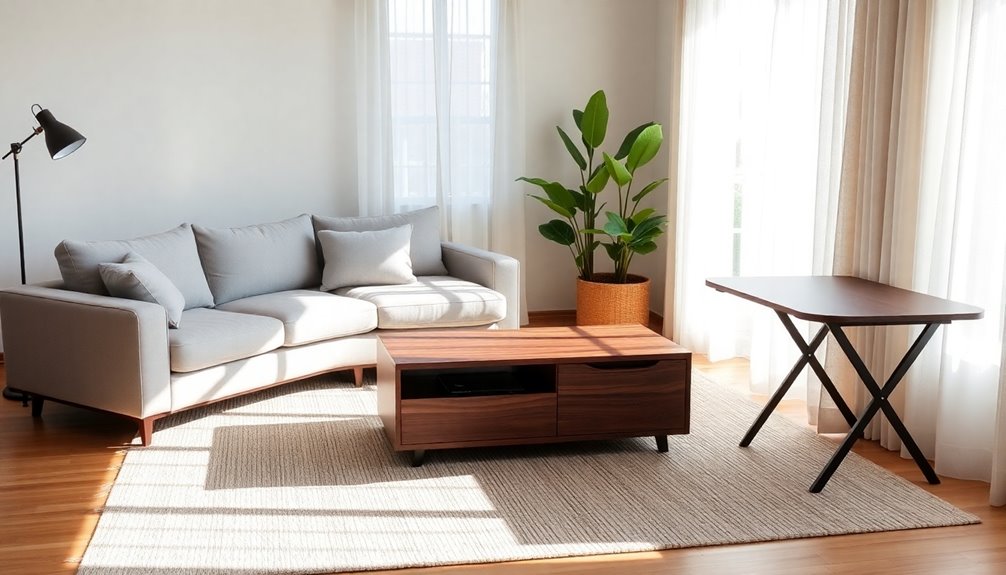
When you’re designing a multi-purpose room, choosing versatile furniture options is key to maximizing your space.
Look for designs that save room, like a sofa bed or a dining table that doubles as a workspace.
These smart choices make it easy to adapt your space for any occasion. Additionally, incorporating vintage or distressed furniture can enhance the overall aesthetic while providing functionality.
Versatile Furniture Options
To create a truly functional multi-purpose room, you’ll want to embrace versatile furniture options that adapt to your changing needs.
Opt for dual-purpose furniture like sofa beds or futons to maximize functionality, effortlessly shifting from seating to sleeping. Incorporate nesting tables for compact storage that can be separated when you need extra surface area.
Consider ottomans with hidden storage to provide additional seating while keeping clutter at bay. Expandable dining tables can accommodate larger gatherings but remain compact for everyday use, enhancing your dining area’s versatility.
Finally, invest in modular furniture pieces that can be rearranged or reconfigured to suit various activities, ensuring your space evolves with you over time. Additionally, incorporating natural elements into your decor can further enhance the room’s calming ambiance.
Space-Saving Designs
Embracing space-saving designs can transform your multi-purpose room into a functional haven. Incorporate multi-purpose furniture like sofa beds or ottomans with storage to reduce clutter while enhancing functionality.
Consider foldable or extendable tables that adapt to your needs, serving both dining and work tasks without taking up extra space. Utilize vertical space with tall shelves or wall-mounted desks; this keeps the floor area open and airy.
Invest in dual-function pieces, such as a coffee table that converts into a desk, to maximize utility without overcrowding your room layout.
Finally, choose aesthetically cohesive multi-purpose items that align with your overall design theme, fostering a unified look while enhancing versatility. This approach creates a harmonious environment for all your activities. Additionally, incorporating lighting design can further enhance the ambiance and functionality of your multi-purpose room.
Maximizing Space With Strategic Layout
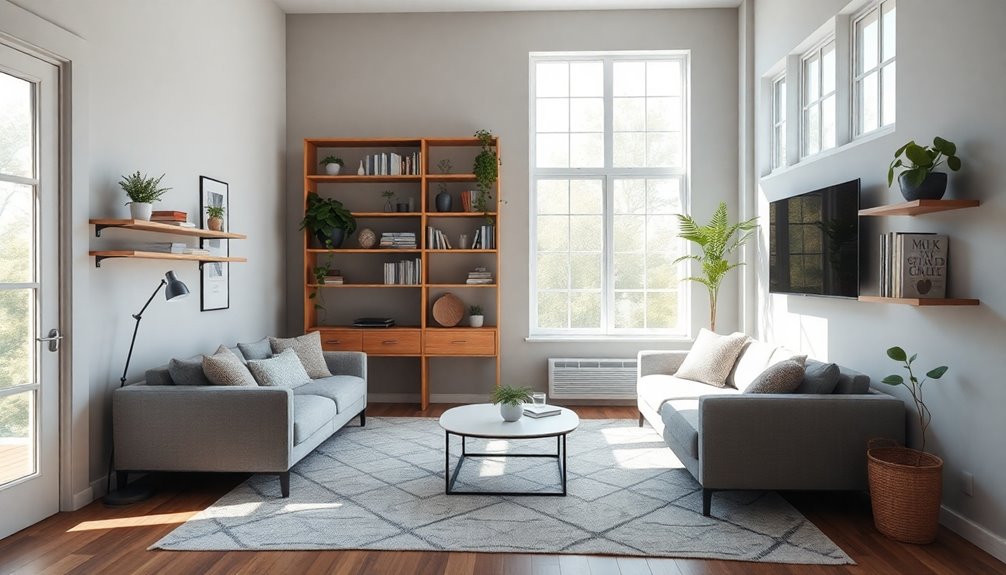
Maximizing space in a multi-purpose room requires thoughtful planning and a strategic layout that accommodates various activities.
Thoughtful planning and a strategic layout are essential for maximizing space in multi-purpose rooms to accommodate diverse activities.
Start by identifying the primary function of the room and allocate the largest area for that purpose.
Next, consider these strategies to enhance your design:
- Utilize vertical space: Incorporate shelves and cabinets to reduce clutter and maximize storage.
- Create defined zones: Arrange furniture to establish areas for activities like reading or working, promoting fluid movement.
- Choose dual-purpose furniture: Opt for items like a sofa bed or extendable dining table to boost functionality without crowding the space.
Additionally, consider using sustainable materials in your decor to enhance the room’s aesthetic while being environmentally conscious.
Regularly reassess your layout to guarantee it meets your evolving needs, keeping the design practical and cohesive over time.
Adding Personal Touches and Decor
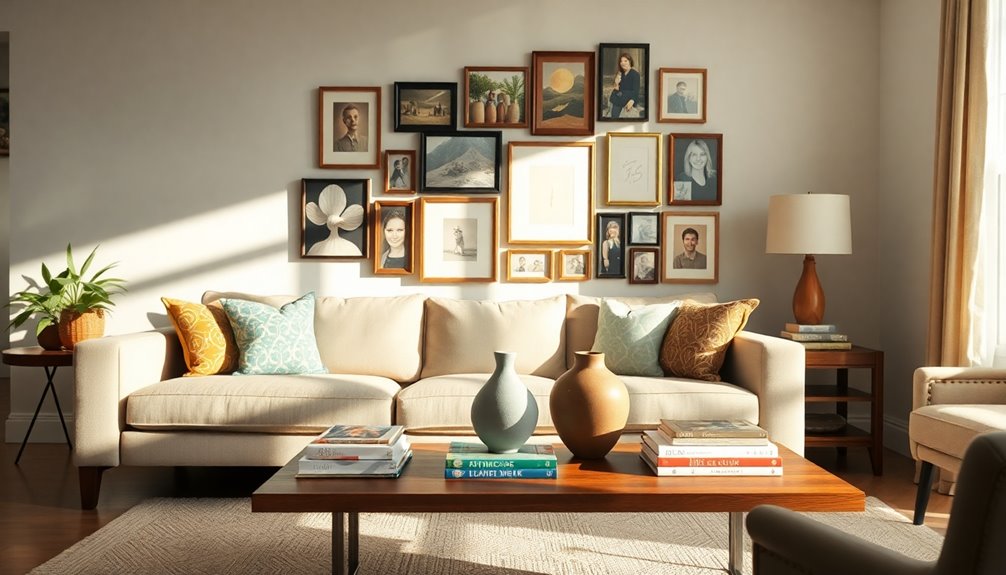
While designing a multi-purpose room, adding personal touches and decor can transform it into a space that truly reflects your style and personality. Consider incorporating personal artwork or photographs to enhance the emotional connection. Utilize decorative accessories like throw pillows and blankets that resonate with your chosen color palette for warmth and cohesion. A gallery wall with frames in consistent finishes can unify various art pieces, contributing to a cohesive aesthetic. Select textiles and items featuring complementary textures, such as wood, metal, and fabric, to enhance visual interest. Regularly rotate decor elements to keep the space fresh while aligning with your primary design style. Additionally, incorporating earthy color palettes can create a harmonious and serene atmosphere throughout the room.
| Personal Touches | Decorative Accessories | Textiles |
|---|---|---|
| Artwork | Throw pillows | Soft blankets |
| Family photographs | Decorative vases | Textured curtains |
| Travel souvenirs | Colorful rugs | Mixed fabric cushions |
| Seasonal decor | Wall decor | Woven baskets |
| Themed accessories | Lighting fixtures | Quilted throws |
Maintaining a Clutter-Free Environment

A well-decorated multi-purpose room can quickly become overwhelming if clutter takes hold.
To maintain a clutter-free environment, consider these strategies:
Consider these strategies to maintain a clutter-free environment and enjoy a beautifully organized multi-purpose room.
- Designate Defined Spaces: Create specific zones for different activities to help manage your belongings and avoid overcrowding.
- Utilize Smart Storage Solutions: Incorporate decorative bins and wall-mounted shelves to keep items out of sight while remaining accessible, enhancing both functionality and aesthetics.
- Adopt the “One In, One Out” Rule: For every new item you bring in, remove one to maintain balance and guarantee your organized space remains clutter-free. Regular maintenance and inspections of your gear and equipment can also help prevent accumulation of unused items.
Utilizing Decorative Storage Solutions
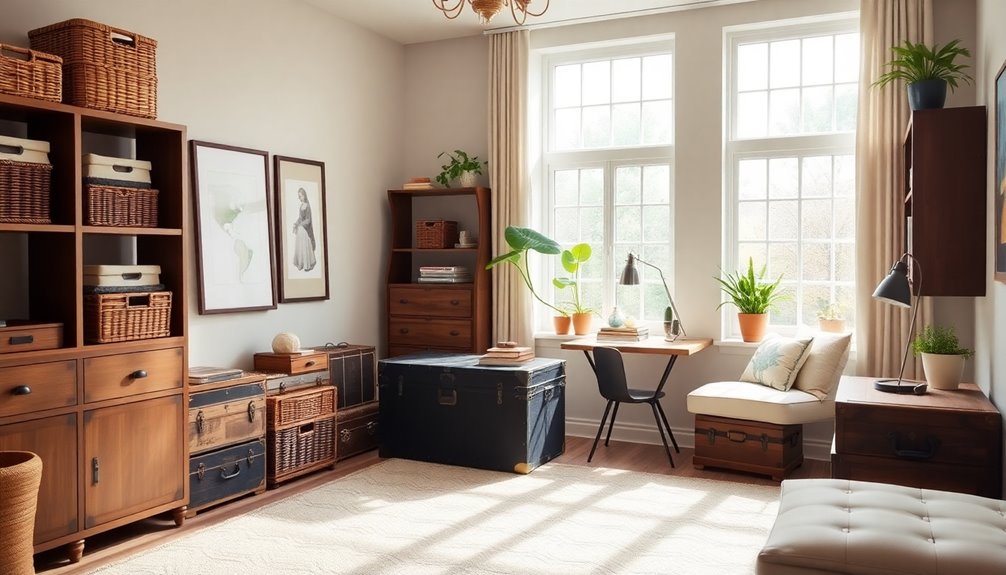
One of the best ways to keep your multi-purpose room organized and stylish is by incorporating decorative storage solutions. Stylish baskets, bins, and shelves help maintain organization while enhancing the cohesive look of your space, aligning perfectly with your design theme.
Consider furniture with built-in storage, like ottomans or coffee tables with hidden compartments, to maximize functionality without sacrificing style.
Utilize vertical space with wall-mounted shelves for both practical storage and a display area for decorative items, adding visual interest.
Choose storage solutions that complement your color palette and textures—matching bins to your wall color or using similar materials—will enhance the overall design.
Regularly reassessing these items keeps the space feeling fresh and inviting, reinforcing its multi-purpose functionality. Additionally, implementing the four-box method can streamline the decluttering process, ensuring that your storage solutions remain effective over time.
Ensuring a Welcoming Atmosphere for All Activities
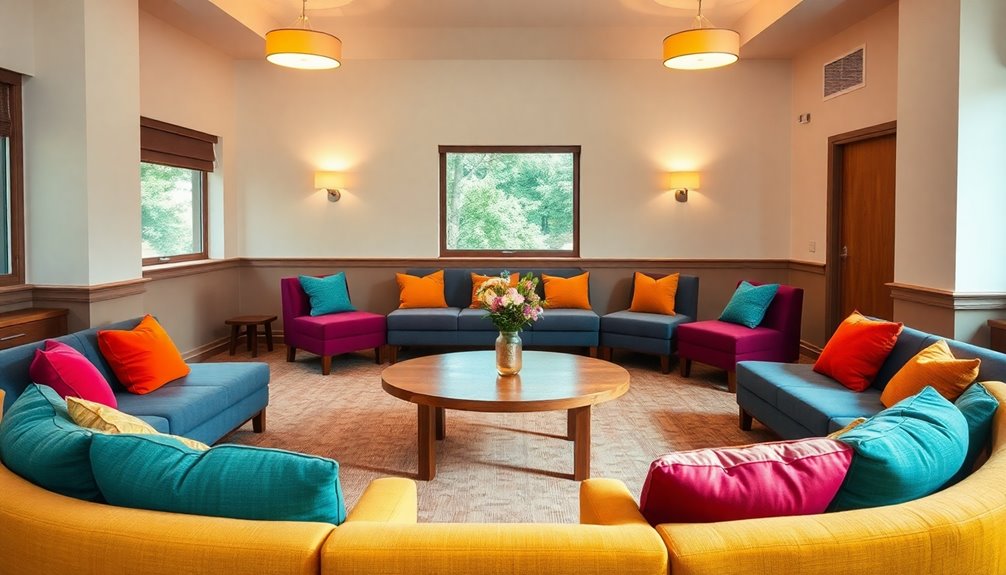
To create a welcoming atmosphere in your multi-purpose room, start with a warm color palette that invites comfort and relaxation.
Arrange furniture to define functional zones, making it easy to switch between activities like work and socializing.
These thoughtful choices will enhance the overall mood and usability of the space for everyone. Additionally, incorporating music therapy techniques can further enrich the environment by promoting emotional well-being and reducing stress levels.
Warm Color Palette
When designing a multi-purpose room, choosing a warm color palette can greatly enhance the atmosphere, making it feel inviting and comfortable for all activities.
Opt for shades like soft beige, muted terracotta, and warm gray to create a cohesive look.
Here are three ideas to implement:
- Limit Your Colors: Stick to a maximum of three complementary colors for a harmonious feel.
- Incorporate Textures: Use accessories like throw pillows and blankets in warm tones to add depth and coziness.
- Accent Walls: Paint one wall in a rich warm color to define zones, allowing for smooth shifts between activities.
Functional Furniture Arrangement
Creating a functional furniture arrangement not only defines different activity zones but also enhances the overall flow of your multi-purpose room.
Use area rugs to separate spaces, like a cozy reading nook from a workspace, helping you maintain focus. Opt for dual-purpose furniture, such as a sofa bed or storage ottoman, to maximize functionality without cluttering the area.
Keep pathways clear, ensuring easy movement and a welcoming atmosphere as you shift between activities. Incorporate flexible seating options, like movable chairs or stools, that adapt to gatherings or solo tasks, enhancing the room’s versatility.
Finally, use visual cues like color schemes to create a cohesive look, connecting various zones while still allowing each area to serve its unique purpose.
Frequently Asked Questions
How to Make a Space Feel Cohesive?
To make a space feel cohesive, start by choosing a limited color palette, using three colors or fewer.
Add visual continuity by repeating textures and materials throughout the room.
Guarantee your design styles are consistent; matching finishes and architectural elements can create a unified atmosphere.
Incorporate similar framing styles in your wall decor for a gallery effect.
Finally, regularly reassess your furniture arrangement to maintain harmony in both functionality and aesthetics.
How Can You Create a Feeling of Balance in a Room?
To create a feeling of balance in a room, start by choosing a cohesive color palette with three harmonious colors.
Mix textures like wood, fabric, and metal for depth.
Arrange your furniture symmetrically, placing larger pieces across from each other to promote flow.
Use a combination of ambient, task, and accent lighting to highlight key areas without overwhelming the space.
Finally, regularly declutter to maintain an organized, inviting atmosphere that feels balanced.
How Do You Make a Room Feel Put Together?
To make a room feel put together, think of it like composing a symphony. Limit your color palette to three main hues and weave textures like wood, fabric, and metal throughout.
Stick to a primary design style, adding a few unexpected touches for flair. Create a gallery wall with similar frame styles to unify your art.
Finally, choose furniture that shares undertones, embracing an eclectic mix to harmonize the overall aesthetic.
How to Create a Multifunctional Living Room?
To create a multifunctional living room, start by choosing versatile furniture like a sofa bed or a storage coffee table.
Define distinct zones for activities, such as a cozy reading corner with a chair and lamp.
Stick to a cohesive color palette and textures to unify the space.
Incorporate multifunctional decor, like decorative baskets for storage, and regularly refresh your layout to keep the room inviting and adaptable to your changing needs.
Conclusion
Creating a cohesive multi-purpose room is like crafting a beautiful symphony; each element should harmonize with the others. Picture a musician playing various instruments, seamlessly shifting from one to another. When you assess your needs, choose a color palette, and incorporate versatile furniture, you’re tuning your space to perfection. By keeping it clutter-free and adding personal touches, you’ll create an inviting atmosphere where every activity can thrive, making your room a true masterpiece.
